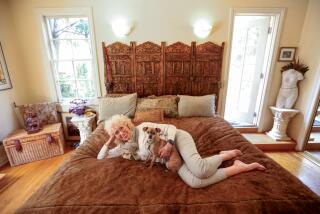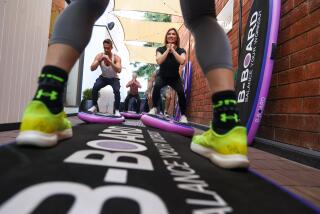Dave Sweet dies at 86; father of the modern foam surfboard
- Share via
The first time Dave Sweet went surfing, in 1945, he was 16 and his wooden board weighed more than he did.
A decade later, he was launching a revolution that would turn those bulky boards into relics.
Sweet, who played a pioneering role in introducing the foam surfboard that transformed the sport and helped propel it into the mainstream, died of renal failure May 18 at the Veterans Affairs West Los Angeles Medical Center, said his son, Greg Sweet. He was 86.
The development and marketing of the foam surfboard has often been credited to Orange County surf entrepreneurs Hobie Alter and Gordon “Grubby” Clark. Sweet didn’t bother to claim credit for decades, but he began manufacturing and selling polyurethane foam boards in 1956, more than a year before the other two began mass-producing theirs.
“Dave Sweet got there first,” surfing historian Matt Warshaw said of Sweet’s pivotal role in the rise of the lighter, more nimble “foamies.”
“He didn’t want to be out there singing and dancing and marketing to get people’s attention. He just wanted to make a board and sell it to you and forget all the stuff that went along with that.”
Although others were experimenting with foam in the 1950s, Sweet “was the first to put it into production use and succeed,” said Steve Pezman, co-founder of The Surfer’s Journal. “Sweet was part of the intelligentsia that caused the modern board to come about.”
Six decades after Sweet’s first trials with foam, his boards are collectors’ items. The Smithsonian Institution in Washington acquired one of his boards for a 1988 exhibit showcasing American craftsmanship.
David Milton Sweet was born in Seattle on Dec. 21, 1928, one of three sons of Ralph M. Sweet and Nell Stowell. His father, who was in the insurance business, fell in love with Southern California after visiting the area and moved the family to Los Angeles when Dave was about 11.
A few years later, they relocated to Topanga Canyon. Sweet began surfing at Topanga Beach on a borrowed redwood board that weighed close to 120 pounds.
After graduating from John Marshall High School he earned a business degree from USC in 1953. He served briefly in the Navy during the Korean War but was discharged after he contracted pneumonia.
As a teenager he had fashioned some boards out of balsa wood. He also helped Matt Kivlin and Joe Quigg develop the Malibu chip longboard, so-named because it resembled a giant potato chip. Warshaw describes the chip as the first board designed for turning.
At around 30 to 40 pounds, balsa boards weighed less than the unwieldy plank on which Sweet had learned to ride waves, but he was determined to find a material that was even lighter and less expensive than wood.
Around 1953 he came upon a large piece of Styrofoam but gave up on it when he found it was difficult to shape and seal.
Then he discovered polyurethane, a resilient, synthetic material developed during World War II that had just hit the commercial market.
He turned his room in a Hollywood boardinghouse into a workshop, selling his car and tapping his savings to finance his experiments.
The next few years were an arduous period of trial and error. He tried different kinds of molds and various formulas for the polyurethane foam. He turned out dozens of rejects, most of which were marred by air bubbles.
Sometimes his efforts with the fast-expanding foam literally blew up.
“More than a couple of times we ran for our lives, away from a creaking mold on the threshold of its capacity,” he told surfing historian Mark Fragale in 2000. “Steel latch bolts once flew through the air like bullets.”
After filling dumpsters with his failures, Sweet finally figured out how to eliminate the bubbles. In 1956 he set his foam boards—which weighed about 25 pounds--on a stand on Malibu beach and began selling them.
“It was easy to ride and control, nice and light and didn’t ding easily,” recalled Howard Terrill, who met Sweet on the beach when both were still in grade school and later bought one of his first foam boards. “His boards handled well and were easy to turn and get into the waves.”
Sweet became a surf industrialist at a propitious time. In 1956 a petite teenager named Kathy Kohner joined the Malibu scene, where a local surfer dubbed her Gidget, a mash up of “girl” and “midget.” Her father, Frederick Kohner, was inspired by her beach adventures to write the novel “Gidget, the Little Girl with Big Ideas,” which led to the 1959 movie starring Sandra Dee in the title role.
“The foam board, along with ‘Gidget,’ allowed surfing to explode,” Warshaw said. Over the next several years, surfing grew from a subculture of a few thousand enthusiasts to millions.
“I met Dave Sweet in Malibu,” recalled Kohner, who goes by her married name, Zuckerman. “I was 16 or 17 and he was part of the older crowd, but I remember he was a very kind … nice-looking man.”
Sweet’s brother Roger briefly joined him in the foam-board business but split to start a partnership with actor Cliff Robertson, soon to be famous as “Kahuna” in the “Gidget” film. They formed Robertson/Sweet Surfboards, which concentrated on churning out low-cost foam boards. The company was short-lived.
Sweet preferred to focus on quality rather than quantity. By the end of 1958 the orders were flying into his Santa Monica shop, which produced no more than 800 boards a year until it closed in 1974. Dave Sweet Surfboards was regarded as a premium brand that attracted top surfers like Tom Morey and Jamie Budge as well as celebrities, including James Arness, Dick Van Dyke and Peter Lawford.
Sweet married Bonnie Mae Johnson in 1958; they were divorced in 1973. He later married Jane Fellows; that marriage ended in 1983. Besides his son, Sweet is survived by brothers Roger and Richard.
The advent of shortboards in the late 1960s put many longboard makers out of business, including Sweet. When he closed his company, he turned to other ventures, including making fiberglass furniture and log-shaped foam planter boxes.
In 2000, spurred in part by an article in Longboard Magazine that drew attention to his role in surfing history, Sweet began designing and selling longboards again. In 2007 he was inducted into the International Surfboard Builders Hall of Fame.
Twitter: @ewooLATimes
More to Read
Start your day right
Sign up for Essential California for the L.A. Times biggest news, features and recommendations in your inbox six days a week.
You may occasionally receive promotional content from the Los Angeles Times.







